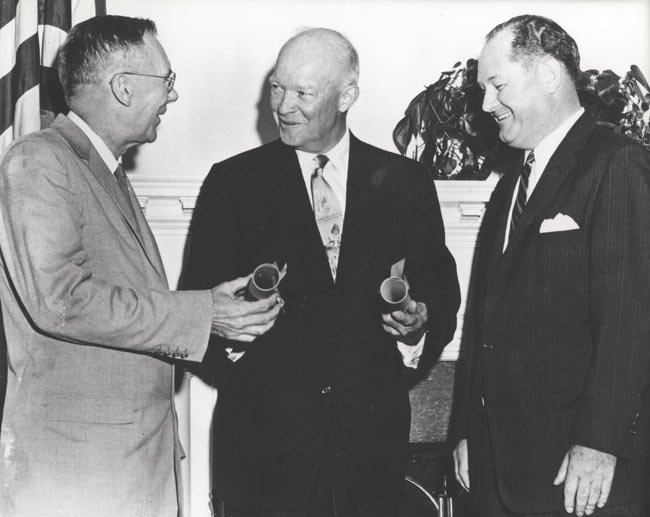50 Years Ago: NASA Born in Sputnik's Wake

The successful launch of the Soviet Union's first two satellites prompted U.S. President Dwight D. Eisenhower and Congress to put aside their differences and create a lasting national space policy and the institution tasked with carrying it out.
On July 29, 1958, Eisenhower signed the National Aeronautics and Space Act, officially establishing NASA.
Before its creation, the United States did not have a space program per se, according to Eilene Galloway, who helped draft the NASA charter and now serves as honorary director of the International Institute of Space Law. However, separate programs did exist within the U.S. military services, including the Navy s Vanguard, the Air Force' s Man in Space Program, and the Army' s Jupiter and Juno programs, said Ted Spitzmiller, a space historian and author of "Astronautics: Book 1: Dawn of the Space Age."
But the launch of the two Sputnik spacecraft in October and November 1957 catalyzed the decision to implement a broader mandate for space activities and programs, Spitzmiller said in a July 16 telephone interview.
The first Sputnik launch was a day Galloway remembers vividly. "Everybody became absolutely terrified," she said in a July 22 interview. "It brought the whole world together in fear."
Galloway, then a national defense analyst with no experience in space matters, was called on to analyze the threat from Soviet ICBMs.
In November 1957, Senate Majority Leader Lyndon Johnson (D-Texas), chairman of the Senate Armed Services preparedness subcommittee, held hearings on the perceived threat of Soviet ICBMs. Galloway was responsible for analyzing the expert testimonies.
Get the Space.com Newsletter
Breaking space news, the latest updates on rocket launches, skywatching events and more!
Since the Soviets orbited a satellite before the United States, Johnson felt Eisenhower was allowing U.S. missile technology to slip behind, Spitzmiller said. However, Eisenhower did not believe the Soviets possessed superior missile technology and was determined to keep the public's focus on space as a civil effort, Spitzmiller said. Eisenhower did not want to enter a space race with the Soviets and likely would not have made NASA a top level priority because he considered much of it a waste of resources.
But Eisenhower did not successfully communicate his position to the public, and thus was attacked by the Democrats — especially by Johnson, Spitzmiller said.
To the credit of both men, Eisenhower and Johnson found common ground to establish NASA — the senator softened his militaristic stance on space and the president agreed to back an overarching national space organization , Spitzmiller said.
The testimonies of scientists and engineers during the subcommittee hearings changed Johnson's perception of space as a battlefield to one wrought with scientific and commercial opportunities, Galloway said. Some scientists spoke of the Sputnik satellites as part of a peaceful effort the International Geophysical Year, she said.
Meanwhile, the president's science advisor, James Killian, helped Eisenhower see the need for a larger, more authoritative space infrastructure, Spitzmiller said.
Johnson's hearings were completed in January 1958, and later that month the U.S. government decided to create a civil space agency, Spitzmiller said.
The National Aeronautics and Space Act was completed within nine months of Sputnik 2's launch, Galloway said.
Galloway made sure House Speaker John McCormack (D-Mass.) changed the last part of NASA's name from "agency" to "administration," because as an administration, NASA has broader authority to gather resources from other government bodies without relying on voluntary cooperation, she said.
NASA officially began operating Oct. 1, 1958, using the civilian National Advisory Committee for Aeronautics staff and research facilities as its backbone. Other space research facilities, such as the Army's Ballistic Missile Agency in Huntsville, Ala., were integrated into the new space agency as well.
The act transferred authority for military space to the Defense Department, and the Advanced Research Projects Agency was created in February 1958 to head military space research.
NASA's creation was a result of quick, bipartisan cooperation between the Republican president and the Democrat-controlled Congress, Galloway said. That kind of cooperation was shown again when Eisenhower sent Johnson to the United Nations in November 1958 to facilitate an international space policy agreement, she said.
After amending the policy to include a consensus format to appease the Soviet Union, Czechoslovakia and Poland, the Committee on the Peaceful Uses of Outer Space was established in 1959, Galloway said.
The U.S. effort to establish a national space policy, as well as international rules and guidelines for space conduct, was the "beginning of space law," Galloway said.
Join our Space Forums to keep talking space on the latest missions, night sky and more! And if you have a news tip, correction or comment, let us know at: community@space.com.
Based in Washington DC, Clinton is a former freelance science writer for Space.com covering NASA History and Space Exploration. His work has appeared online and in print for Slate, Science, AAAS, the Society for Neuroscience, the American Chemical Society, and the American Physical Society. From October 2006 to May 2015, he acted as a staff writer and web producer for SpaceNews creating "This Week In Space History." He's currently a Content Specialist for National Geographic.









